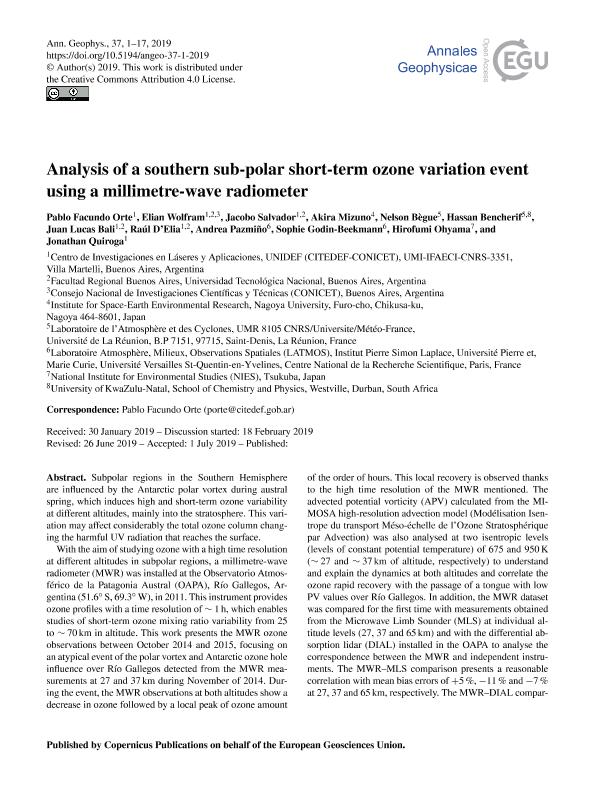Artículo
Analysis of a southern sub-polar short-term ozone variation event using a millimetre-wave radiometer
Orte, Pablo Facundo ; Wolfram, Elian Augusto
; Wolfram, Elian Augusto ; Salvador, Jacobo Omar
; Salvador, Jacobo Omar ; Mizuno, Akira; Bègue, Nelson; Bencherif, Hassan; Bali, Juan Lucas
; Mizuno, Akira; Bègue, Nelson; Bencherif, Hassan; Bali, Juan Lucas ; D'Elia, Raul; Pazmiño, Andrea; Godin Beekmann, Sophie; Ohyama, Hirofumi; Quiroga, Jonathan Javier
; D'Elia, Raul; Pazmiño, Andrea; Godin Beekmann, Sophie; Ohyama, Hirofumi; Quiroga, Jonathan Javier
 ; Wolfram, Elian Augusto
; Wolfram, Elian Augusto ; Salvador, Jacobo Omar
; Salvador, Jacobo Omar ; Mizuno, Akira; Bègue, Nelson; Bencherif, Hassan; Bali, Juan Lucas
; Mizuno, Akira; Bègue, Nelson; Bencherif, Hassan; Bali, Juan Lucas ; D'Elia, Raul; Pazmiño, Andrea; Godin Beekmann, Sophie; Ohyama, Hirofumi; Quiroga, Jonathan Javier
; D'Elia, Raul; Pazmiño, Andrea; Godin Beekmann, Sophie; Ohyama, Hirofumi; Quiroga, Jonathan Javier
Fecha de publicación:
07/2019
Editorial:
Copernicus Publications
Revista:
Annales Geophysicae
ISSN:
0992-7689
e-ISSN:
1432-0576
Idioma:
Inglés
Tipo de recurso:
Artículo publicado
Clasificación temática:
Resumen
Subpolar regions in the Southern Hemisphere are influenced by the Antarctic polar vortex during austral spring, which induces high and short-term ozone variability at different altitudes, mainly into the stratosphere. This variation may affect considerably the total ozone column changing the harmful UV radiation that reaches the surface. With the aim of studying ozone with a high time resolution at different altitudes in subpolar regions, a millimetre-wave radiometer (MWR) was installed at the Observatorio Atmosférico de la Patagonia Austral (OAPA), Río Gallegos, Argentina (51.6∘ S, 69.3∘ W), in 2011. This instrument provides ozone profiles with a time resolution of ∼1 h, which enables studies of short-term ozone mixing ratio variability from 25 to ∼70 km in altitude. This work presents the MWR ozone observations between October 2014 and 2015, focusing on an atypical event of the polar vortex and Antarctic ozone hole influence over Río Gallegos detected from the MWR measurements at 27 and 37 km during November of 2014. During the event, the MWR observations at both altitudes show a decrease in ozone followed by a local peak of ozone amount of the order of hours. This local recovery is observed thanks to the high time resolution of the MWR mentioned. The advected potential vorticity (APV) calculated from the MIMOSA high-resolution advection model (Modélisation Isentrope du transport Méso-échelle de l'Ozone Stratosphérique par Advection) was also analysed at two isentropic levels (levels of constant potential temperature) of 675 and 950 K (∼27 and ∼37 km of altitude, respectively) to understand and explain the dynamics at both altitudes and correlate the ozone rapid recovery with the passage of a tongue with low PV values over Río Gallegos. In addition, the MWR dataset was compared for the first time with measurements obtained from the Microwave Limb Sounder (MLS) at individual altitude levels (27, 37 and 65 km) and with the differential absorption lidar (DIAL) installed in the OAPA to analyse the correspondence between the MWR and independent instruments. The MWR–MLS comparison presents a reasonable correlation with mean bias errors of +5 %, −11 % and −7 % at 27, 37 and 65 km, respectively. The MWR–DIAL comparison at 27 km also presents good agreement, with a mean bias error of −1 %.
Palabras clave:
sensado remoto
,
agujero de ozono
,
vortice polar
Archivos asociados
Licencia
Identificadores
Colecciones
Articulos(UNIDEF)
Articulos de UNIDAD DE INVESTIGACION Y DESARROLLO ESTRATEGICOS PARA LA DEFENSA
Articulos de UNIDAD DE INVESTIGACION Y DESARROLLO ESTRATEGICOS PARA LA DEFENSA
Citación
Orte, Pablo Facundo; Wolfram, Elian Augusto; Salvador, Jacobo Omar; Mizuno, Akira; Bègue, Nelson; et al.; Analysis of a southern sub-polar short-term ozone variation event using a millimetre-wave radiometer; Copernicus Publications; Annales Geophysicae; 37; 4; 7-2019; 613-629
Compartir
Altmétricas



